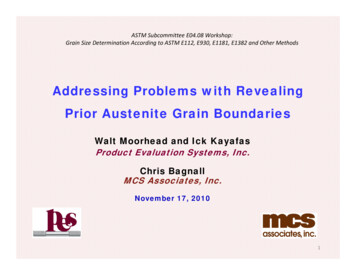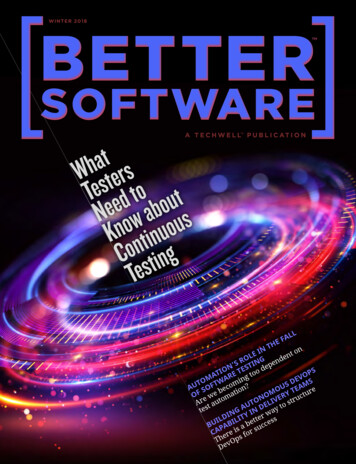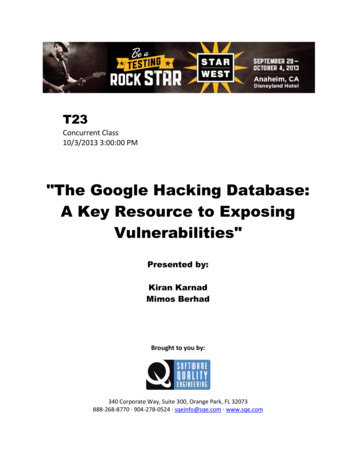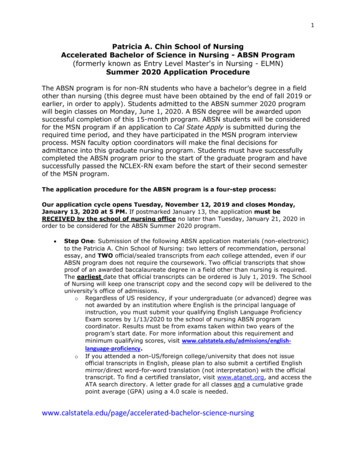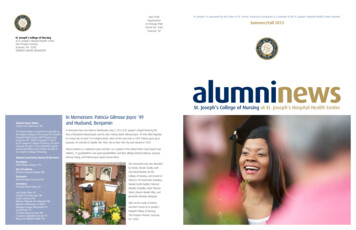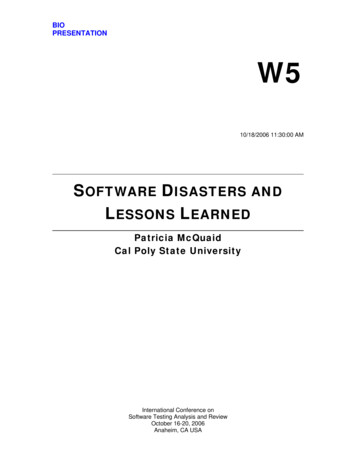
Transcription
BIOPRESENTATIONW510/18/2006 11:30:00 AMSOFTWARE DISASTERS ANDLESSONS LEARNEDPatricia McQuaidCal Poly State UniversityInternational Conference onSoftware Testing Analysis and ReviewOctober 16-20, 2006Anaheim, CA USA
Patricia A. McQuaidPatricia A. McQuaid, Ph.D., is a Professor of Information Systems at California PolytechnicState University, USA. She has taught in both the Colleges of Business and Engineeringthroughout her career and has worked in industry in the banking and manufacturing industries.Her research interests include software testing, software quality management, software projectmanagement, software process improvement, and complexity metrics.She is the co-founder and Vice-President of the American Software Testing Qualifications Board(ASTQB). She has been the program chair for the Americas for the Second and Third WorldCongresses for Software Quality, held in Japan in 2000 and Germany in 2005.She has a doctorate in Computer Science and Engineering, a masters degree in Business, anundergraduate degree in Accounting, and is a Certified Information Systems Auditor (CISA).Patricia is a member of IEEE, a Senior Member of the American Society for Quality (ASQ), anda member of the Project Management Institute (PMI). She is on the Editorial Board for theSoftware Quality Professional journal, and also participates on ASQ’s Software Division Council.She was a contributing author to the Fundamental Concepts for the Software Quality Engineer(ASQ Quality Press) and is one of the authors of the forthcoming ASQ Software QualityEngineering Handbook (ASQ Quality Press).
Software Disasters and LessonsLearned Patricia McQuaid, Ph.D.Professor of Information SystemsCalifornia Polytechnic State UniversitySan Luis Obispo, CASTAR West October 2006
Agenda for Disaster Therac-25 Denver Airport Baggage Handling Mars Polar Lander Patriot Missile
Therac-25“One of the most devastating computerrelated engineering disasters to date”
Therac-25{Radiation doses{Typical dosage200 RADS{Worst case dosage20,000 RADS !!!ÎRADS6 people severely injured
Machine Design
Accident History Timeline1.June 1985, Georgia: Katherine Yarbrough, 61z2.3.Overdosed during a follow-up radiation treatment afterremoval of a malignant breast tumor.July 1985, Canada: Frances Hill, 40zOverdosed during treatment for cervical carcinoma.z“No dose” error messagezDies November 1985 of cancer.December 1985 , WashingtonzA woman develops erythema on her hip
Accident History Timeline (continued)4.5.6.March 1986: Voyne Ray CoxzOverdosed; next day, severe radiation sickness.z‘Malfuction 54’zDies August 1986 – radiation burns.April 1986, Texas: Verdon KiddzOverdosed during treatments to his face (treatment to left ear).z‘Malfuction 54’zMay 1986: dies as a result of acute radiation injury to the righttemporal lobe of the brain and brain stem.January 1987, Washington : Glen A. Dodd, 65z(same location in Washington as earlier woman) overdosedzApril 1987: dies of complications from radiation burns to his chest.
What led to these problems?{FDA’S “pre-market approval”{Reliance on the software for safety – not yetproven{No adequate software quality assuranceprogram{One programmer created the software{Assumed that re-used software is safe{AECL - unwilling to acknowledge problems
Multitude of Factors and InfluencesResponsiblePoor coding practices1. Race conditions, overflow problems2.Grossly inadequate software testing3.Lack of documentation4.Lack of meaningful error codes5.AECL’s unwillingness or inability to resolveproblems6.FDA’s policies for reporting known issues werepoor
Poor User Interface
Lessons Learned{There is a tendency to believe that the cause of anaccident had been determined. Investigate more.{Keep audit trails and incident analysis proceduresz{Follow the basic premises of software engineeringzzzz{Follow through on reported errorsComplete documentationEstablished software quality practicesClean designsExtensive testing at module, integration, and system levelDo NOT assume reusing software is 100% safe
Fear and Loathing inDenver International
Background Opened in 1995 8th most trafficked airport in the world Fully automated luggage system Able to track baggage entering, transferring, and leaving Supposed to be extremely fast – 24 mph (3x fast as conveyor systems) Uses Destination Coded Vehicles (telecars) The plan: 9 minutes to anywhere in the airport Planned cost: 193 million Actual cost: over 640 million Delay in opening the airport: 16 months
System Specifications
Project PlanningConstruction Poor planning Poor designs Challenging constructionTimetable 3-4 year project to be completed in 2 years Airport opening delayed 16 months Coding Integrate code into United’s existing Apolloreservation system
Cart Failures Routed to wrong locations Sent at the wrong time Carts crashed and jumped the tracks Agents entered information too quickly,causing bad data Baggage flung off telecarts Baggage could not be routed, went tomanual sorting station Line balancing / blocking Baggage stacked up
Hardware Issues Computers Î insufficient Could not track carts Redesigned system Different interfaces caused system crashes Scanners Hard to read barcodes Poorly printed baggage tags Sorting problems, if dirty or blocked Scanners crashed into could no longer read Faulty latches dumped baggage
Project CostsTotal cost:over 640 millionA system with ZEROfunctionality
Lessons Learned Spend time up front on planning and design Employ risk assessment and risk-based testing Control scope creep Develop realistic timelines Incorporate a formal Change Management process Enlist top management support Testing - integration testing; systems testing Be cautious when moving into areas you have no expertise in Understand the limits of the technology
Mars Polar Lander
Why have a Polar Lander?zAnswer the questions:Could Mars be hospitable?Is there bacteria in the sub-surface of the planet?Is it really water that we have seen evidence of or not?zFollow up on prior missionsMars Climate Orbiter 1999Mars Surveyor Program 1998zPlain ole’ curiosityDo they really look like that?Æ
Timeline of MissionzLaunched Jan 3, 1999from Cape CanaveralzGets to Mars atmosphereDec 3, 1999 @ 12:01amPSTz12:39am PST engineerswait for the signal that isto reach Earth anysecond
What happened?zWe don’t know.zUnable to contact the 165 millionPolar Lander.zVarious reported “potential”sightings inMarch 2001, and May 2005.zError in rocket thrusters - landing.zConspiracy theoryzzType of fuel usedLanding gear not tested properly
What went wrong?zCoding and human errorszAn error in one simple line of codezzzzzzzzShut down the engines too early Î crashedFeature creep and inadequate testingTeams were unfamiliar with the spacecraftSome teams improperly trainedSome teams drastically overworkedInadequate managementNo external independent oversight of the teamsSoftware complexity (problem for aerospace industry)
Lessons LearnedzEmploy the proper management philosophyzDon’t just get the job done, get the job done right.zControl scope creepzTest, test, test!zTrain your people, including managerszDo not overwork your people for long periods of timezManage your peoplezBuild in adequate safety marginszDocument all aspects of the project
Patriot MissileDisaster
Missiles 7.4 feet longPowered by asingle stage solidpropellant rocketmotorWeighs 2,200poundsRange of 43 miles
Launcher Transports, points,and launches themissile4 missiles perlauncherOperated remotelyvia a link to thecontrol station
Radar Carries out search, targetdetection, track, andidentificationResponsible for missiletracking, guidance, andelectronic countercounter-measuresMounted on a trailerControlled by a computerin the control area
Operation1.2.3.4.5.Target is acquired by the radar.Information is downloaded to thecomputer.Missile is launched.Computer guides missile to target.A proximity fuse detonates thewarhead.
Disaster
February 25, 1991 Dhahran,Saudi Arabia SCUDhits Army barracks killing 28people and injuring 97 others Patriotfails to track the incomingmissile; did not even launch!
What Went Wrong? Designed as anti-aircraft, not anti-missile Expected: a mobile unit, not a fixed location Designed to operate for a few hours at a time– Had been running continuously for 4 days– After 8 continuous hours stored clock value,off by .0275 seconds 55 meter error– For 100 hours stored clock value is off by.3433 seconds 687 meter error
Timeline February 11– Israelis notify US of loss of accuracy problem February 16– Software fixes made to correct timing error– Update sent out to troops February 25– The attack! February 26– Update arrives in Saudi Arabia
Lessons Learned Robust testing needed for safety-criticalsoftware– Test the product for the environment it will beused in.– Test under varying conditions System redesigns – be careful – Special care needed when redesigning a systemfor a new use Clear communication– Among the designers, developers, and operators– Dispatch fixes quickly!
The End!Thank you for attending
Software Disasters and Lessons LearnedPatricia McQuaid, Ph.D.Professor of Information SystemsCalifornia Polytechnic State UniversitySan Luis Obispo, CA 93407AbstractSoftware defects come in many forms - from those that cause a brief inconvenience, to those that causefatalities. It is important to study software disasters, to alert developers and testers to be ever vigilant, andto understand that huge catastrophes can arise from what seem like small problems. This paper examinessuch failures as the Therac-25, Denver airport baggage handling, the Mars Polar Lander, and the Patriotmissile. The focus is on factors that led to these problems, an analysis of the problems, and then thelessons to be learned that relate to software engineering, safety engineering, government and corporateregulations, and oversight by users of the systems.Introduction“Those who cannot remember the past are condemned to repeat it”, said George Santayana, a Spanishborn philosopher who lived from 1863 to 1952 [1].Software defects come in many forms, from those that cause a brief inconvenience to those that causefatalities, with a wide range of consequences in between. This paper focuses on four cases: the Therac-25radiation therapy machine, the Denver airport baggage handling system, the Mars Polar Lander, and thePatriot missile. Background is provided, factors that led to these problems are discussed, the problemsanalyzed, and then the lessons learned from these disasters are discussed, in the hopes that we learn fromthem and do not repeat these mistakes.Therac-25 Medical AcceleratorThe first disaster discussed in this paper deals with the Therac-25, a computerized radiation therapymachine that dispensed radiation to patients. The Therac-25 is one of the most devastating computerrelated engineering disasters to date. It was one of the first dual-mode medical linear accelerationmachines developed to treat cancer, but due to poor engineering, it led to the death or serious injury of sixpeople. In 1986, two cancer patients in Texas received fatal radiation overdoses from the Therac-25. [2]In an attempt to improve software functionality, the Atomic Energy Commission Limited (AECL) and aFrench company called CGR developed the Therac-25. There were earlier versions of the machine, andthe Therac-25 reused some of the design features of the Therac-6 and the Therac-20. According toLeveson, the Therac-25 was “notably more compact, more versatile, and arguably easier to use” than theearlier versions [3]. However, the Therac-25 software also had more responsibility for maintaining safetythan the software in the previous machines. While this new machine was supposed to provideadvantages, the presence of numerous flaws in the software led to massive radiation overdoses, resultingin the deaths of three people [3].According to its definition, “medical linear accelerators accelerate electrons to create high-energy beamsthat can destroy tumors with minimal impact on the surrounding healthy tissue [3].” As a dual-mode
machine, the Therac-25 was able to deliver both electron and photon treatments. The electron treatmentwas used to radiate surface areas of the body to kill cancer cells, while the photon treatment, also knownas x-ray treatment, delivered cancer killing radiation deeper in the body.The Therac-25 incorporated the most recent computer control equipment, which was to have severalimportant benefits, one of which was to use a double pass accelerator, to allow a more powerfulaccelerator to be fitted into a small space, at less cost. The operator set up time was shorter, giving themmore time to speak with patients and treat more patients in a day. Another “benefit” of the computerizedcontrols was to monitor the machine for safety. With this extensive use of computer control, the hardwarebased safety mechanisms that were on the predecessors of the Therac-25, were eliminated and transferredcompletely to the software, which one will see was not a sound idea [4].The Atomic Energy Commission Limited (AECL), along with a French company called CGR togetherbuilt these medical linear acceleration machines. The Therac-25's X-rays were generated by smashinghigh-power electrons into a metal target positioned between the electron gun and the patient. The olderTherac-20's electromechanical safety interlocks were replaced with software control, because softwarewas perceived to be more reliable [5].What the engineers did not know was that the programmer who developed the operating system used byboth the Therac-20 and the Therac-25 had no formal training. Because of a subtle bug called a “racecondition”, a fast typist could accidentally configure the Therac-25 so the electron beam would fire inhigh-power mode, but with the metal X-ray target out of position [5].The Accidents. The first of these accidents occurred on June 3, 1985 involving a woman who wasreceiving follow-up treatment on a malignant breast tumor. During the treatment, she felt an incredibleforce of heat and the following week the area that was treated began to breakdown and to lose layers ofskin. She also had a matching burn on her back and her shoulder had become immobile. Physicistsconcluded that she received one or two doses in the 20,000 rad (radiation absorbed dose) range, whichwas well over the prescribed 200 rad dosage. When AECL was contacted, they denied the possibility ofan overdose occurring. This accident was not reported to the FDA until after the accidents in 1986.The second accident occurred in July 1985 in Hamilton, Ontario. After the Therac-25 was activated, itshut down after five minutes and showed an error that said “no dose”. The operator repeated the processfour more times. The operators had become accustomed to frequent malfunctions that had no problematicconsequences for the patient. While the operator thought no dosage was given, in reality several doseswere applied and the patient was hospitalized three days later for radiation overexposure. The FDA andthe Canadian Radiation Protection Board were notified and the AECL issued a voluntary recall, while theFDA audited the modifications made to it. AECL redesigned a switch they believed caused the failureand announced that it was 10,000 times safer after the redesign.The third accident occurred in December 1985 in Yakima, Washington where the Therac-25 had alreadybeen redesigned in response to the previous accident. After several treatments, the woman’s skin beganto redden. The hospital called AECL and they said that “after careful consideration, we are of the opinionthat this damage could not have been produced by any malfunction of the Therac-25 or by any operatorerror [3].” However, upon investigation the Yakima staff found evidence for radiation overexposure dueto her symptoms of a chronic skin ulcer and dead tissue.The fourth accident occurred in March 1986 in Tyler, Texas where a man died due to complications fromthe radiation overdose. In this, the message “Malfuction 54” kept appearing, indicating only 6 rads weregiven, so the operator proceeded with the treatment. That day the video monitor happened to beunplugged and the monitor was broken, so the operator had no way of knowing what was happening
inside, since the operator was operating the controls in another room. After the first burn, while he wastrying to get up off the table, he received another dose – in the wrong location since he was moving. Hethen pounded on the door to get the operator’s attention. Engineers were called upon, but they couldn’treproduce the problem so it was put back into use in April. The man’s condition included vocal cordparalysis, paralysis of his left arm and both legs, and a lesion on his left lung, which eventually caused hisdeath.The fifth accident occurred in April 1986 at the same location as the previous one and produced the same“Malfunction 54” error. The same technician who treated the patient in the fourth accident prepared thispatient for treatment. This technician was very experienced at this procedure and was a very fast typist.So, as with the former patient, when she typed something incorrectly, she quickly corrected the error.The same “Malfunction 54” error showed up and she knew there was trouble. She immediately contactedthe hospital’s physicist, and he took the machine out of service. After much perseverance on the parts ofthe physicist and the technician, they determined that the malfunction occurred only if the Therac-25operator rapidly corrected a mistake. AECL filed a report with the FDA and began work on fixing thesoftware bug. The FDA also required AECL to change the machine to clarify the meaning of malfunctionerror messages and shutdown the treatment after a large radiation pulse. Over the next three weeks,however, the patient fell into a coma, suffered neurological damage and died.The sixth and final accident occurred in January 1987, again in Yakima, Washington. AECL engineersestimated that the patient received between 8,000 and 10,000 rads instead of the prescribed 86 rads afterthe system shut down and the operator continued with the treatment. The patient died due tocomplications from radiation overdose.Contributing factors. Numerous factors were responsible for the failure of users and AECL to discoverand correct the problem, and for the ultimate failure of the system. This is partly what makes this case sointeresting; there were problems that spanned a wide range of causes.Previous models of the machine were mostly hardware based. Before this, computer control was notwidely in use and hardware mechanisms were in place in order to prevent catastrophic failures fromoccurring. With the Therac-25, the hardware controls and interlocks which had previously been used toprevent failure were removed. In the Therac-25, software control was almost solely responsible formitigating errors and ensuring safe operation. Moreover, the same pieces of code which had controlledthe earlier versions were modified and adapted to control the Therac-25. The controlling software wasmodified to incorporate safety mechanisms, presumably to replace more expensive hardware controls thatwere still in the Therac-20. To this day, not much is known about the sole programmer who ultimatelycreated the software, other than he had minimal formal training in writing software.Another factor was AECL’s inability or unwillingness to resolve the problems when they occurred, evenin the most serious patient death instances. It was a common practice for their engineering and otherdepartments to dismiss claims of machine malfunction as user error, medical problems with the patientbeyond AECL’s control, and other circumstances wherein the blame would not fall on AECL. Thiscaused users to try and locate other problems which could have caused the unexplained accidents.Next, AECL’s software quality practices were terrible, as demonstrated by their numerous CorrectiveAction Plan (CAP) submissions. When the FDA finally was made aware of the problem, they demandedof AECL that the numerous problems be fixed. Whenever AECL tried to provide a solution for a softwareproblem, it either failed to fix the ultimate problem, or changed something very simple in the code, whichultimately could introduce other problems. They could not provide adequate testing plans, nor barely evenprovide any documentation to support the software they created [3]. For instance, the 64 “Malfunction”
codes were referenced only by their number, with no meaningful description of the error provided to theconsole.FDA interaction at first was poor mainly due to the limited reporting requirements imposed on users.While medical accelerator manufacturers were required to report known issues or defects with theirproducts, users were not, resulting in the governmental agency failing to get involved at the most crucialpoint following the first accident. Had users been required to report suspected malfunctions, the failuresmay well have been prevented. The AECL did not deem the accidents to be any fault on their part, andthus did not notify the FDA.Finally, the defects in the software code were what ultimately attributed to the failures themselves. Pooruser interface controls caused prescription and dose rate information to be entered improperly [3]. Otherpoor coding practices caused failures to materialize, such as the turntable to not be in the proper positionwhen the beam was turned on. For one patient, this factor ultimately caused the radiation burns since thebeam was applied in full force to the victim’s body, without being first deflected and defused to emit amuch lower dosage.Another major problem was due to race conditions. They are brought on by shared variables when twothreads or processes try to access or set a variable at the same time, without some sort of interveningsynchronization. In the case of the Therac-25, if an operator entered all information regarding dosage tothe console, arriving at the bottom of the screen, some of the software routines would automatically starteven though the operator did not issue the command to accept those variables. If an operator then wentback in the fields to fix an input error, it would not be sensed by the machine and would therefore not beused, using the erroneous value instead. This attributed to abnormally high dosage rates due to softwaremalfunction.An overflow occurs when a variable reaches the maximum value its memory space can store. For theTherac-25, a one byte variable named Class3 was used and incremented during the software checkingphase. Since a one byte variable can only hold 255 values in total, on every 256th pass through, the valuewould revert to zero. A function checked this variable and if it was set to 0, the function would not checkfor a collimator error condition, a very serious problem. Thus, there was a 1 in 256 chance every passthrough the program that the collimator would not be checked, resulting in a wider electron beam whichcaused the severe radiation burns experienced by a victim at one of the treatment sites [3].Lessons Learned. The Therac-25 accidents were tragic and provide a learning tool to prevent any futuredisasters of this magnitude. All of the human, technical, and organizational factors must be consideredwhen looking to find the cause of a problem. The main contributing factors of the Therac-25 accidentincluded: “management inadequacies and lack of procedures for following through on all reported incidents overconfidence in the software and removal of hardware interlocks presumably less-than-acceptable software-engineering practices unrealistic risk assessments and overconfidence in the results of these assessments” [3].When an accident arises, a thorough investigation must be conducted to see what sparked it. We cannotassume that the problems were caused by one aspect alone because parts of a system are interrelated.Another lesson is that companies should have audit trails and incident-analysis procedures that are appliedwhenever it appears that a problem may be surfacing. Hazard logging and problems should be recorded asa part of quality control. A company also should not over rely on the numerical outputs of the safetyanalyses. Management must remain skeptical when making decisions.
The Therac-25 accidents also reemphasize the basics of software engineering which include completedocumentation, established software quality assurance practices and standards, clean designs, andextensive testing and formal analysis at the module and software level. Changes in any design changesmust also be documented so people do not reverse them in the future.Manufacturers must not assume that reusing software is 100% safe; parts of the code in the Therac-20 thatwere re-used were found later to have had defects the entire time. But since there were still hardwaresafety controls and interlocks in place on that model, the defects went undetected. The software is a partof the whole system and cannot be tested on its own. Regression tests and system tests must be conductedto ensure safety. Designers also need to take time in designing user interfaces with safety in consideration.According to Leveson [3], “Most accidents involving complex technology are caused by a combination oforganizational, managerial, technical, and, sometimes, sociological or political factors. Preventingaccidents requires paying attention to all the root causes, not just the precipitating event in a particularcircumstance. Fixing each individual software flaw as it was found did not solve the device's safetyproblems. Virtually all complex software will behave in an unexpected or undesired fashion under someconditions -- there will always be another bug. Instead, accidents must be understood with respect to thecomplex factors involved. In addition, changes need to be made to eliminate or reduce the underlyingcauses and contributing factors that increase the likelihood of accidents or loss resulting from them.”Denver International Airport Baggage Handling SystemDenver International Airport was to open a new airport in 1995, to replace the aging StapletonInternational Airport. It was to have many new features that pilots and travelers alike would praise, inparticular, a fully automated baggage system. At 193 million dollars, it was the new airports’ crowningjewel [1]. It was to drastically lower operating costs while at the same time improve baggagetransportation speeds and lower the amount of lost luggage.Created and installed by BAE Automated Systems, this technological marvel would mean the airportneeded no baggage handlers. It operated on a system of sensors, scales, and scanners all operated by amassive mainframe. Theft of valuables, lost luggage, and basically all human error would cease to be aproblem in traveling through Denver. The airport and its main carrier, United Airlines, would no longerhave the expenses of paying luggage handlers.Unfortunately, the system didn’t work like it was supposed to. Due to delays in getting the 22 mile longsystem to work, BAE delayed the opening of the airport by 16 months with an average cost of 1.1million per day. Baggage was falling off the tracks and getting torn apart by automated handlers.Eventually a conventional system had to be installed at a cost of 70 million when it became clear theoriginal system wasn’t going to work. This cost, plus the delay in opening the airport, and someadditional costs in installing the system added up to a staggering 640 million for what amounted to aregular baggage system [1].This system has become a poster child for the poor project management that has seemed to pervade mostmajor IT projects. A delay that was almost as long as the original project time and a budget that more thandoubled the target all without a working end system.The Plan. The baggage system of Denver International Airport was to be the pinnacle of modern airportdesign. It was designed to be a fully automated system that took care of baggage from offloading toretrieval by the owner at baggage claim. The system would be able to track baggage coming in, baggagebeing transferred, and a baggage’s final destination at baggage claim. It was to handle the baggage of all
the airlines. The speed, efficiency, and reliability of the new system were also touted to be the mostadvanced baggage handling system in the world. Although the system was to be the world’s mostcomplex baggage technology, it was not the first of its kind. San Francisco International Airport, RheinMain International Airport, and Franz Joseph Strauss Airport all have similar systems but on a muchsmaller scale and of less complexity [3].The high speed of the baggage system is one of the main areas of improvement. The system utilizesDestination-Coded Vehicles (DCV) or telecars capable of rolling on 22 miles of underground tracks at24mph or 3 times as fast as the current conveyor belts in use. The plan was for a piece of baggage to beable to move between any concourse in the airport within 9 minutes. This would shave off minutes inturnaround time between each arriving and departing flight [3].The system was integrated with several high-tech components. “It calls for 300 486-class computersdistributed in eight control rooms, a Raima Corp. database running on a Netframe Systems fault-tolerantNF250 server, a high-speed fiber-optic ethernet network, 14 million feet of wiring, 56 laser arrays, 400frequency readers, 22 miles of track, 6 miles of conveyor belts, 3,100 standard telecars, 450 oversizedtelecars, 10,000 motors, and 92 PLCs to control motors and track switches” [3]. With a system of this sizeand complexity, thorough planning and testing needed to take place to ensure re
Software Quality Professional journal, and also participates on ASQ’s Software Division Council. She was a contributing author to the Fundamental Concepts for the Software Quality Engineer (ASQ Quality Press) and is one of the authors of the forthcoming ASQ Software Quality E

